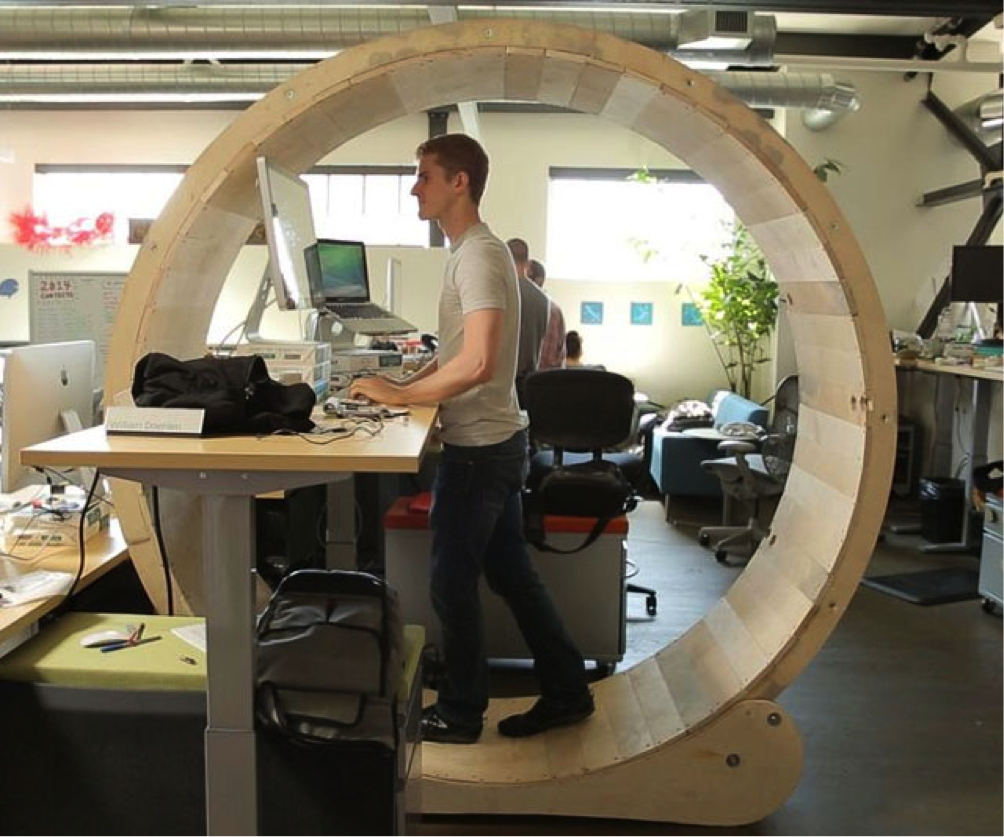Undergraduate perspective on Sports & Exercise Medicine – a BJSM blog series
By Rory Heath (@roryjheath)
Part 2 of a 2-part series
The first part this series reminded us that inactivity in the workplace is bad for your health – as bad as smoking. Sedentary behaviour also reduces workplace productivity; employees report more fatigue and restlessness, while chronic diseases increase time spent on sick leave.
 The Active Working movement can prevent disease, reduce NHS expenditure and increase productivity; but how do we implement it? Here are presentation highlights from the recent Active Working Summit.
The Active Working movement can prevent disease, reduce NHS expenditure and increase productivity; but how do we implement it? Here are presentation highlights from the recent Active Working Summit.
Blood Glucose (CGM) Responses to Sitting and Standing in Desk-Based Workers.
Professor John Buckley, Applied Exercise Science in Health, University of Chester
- 18 mini-breaks from seated positions are better than having one chunk of exercise in a day to reduce blood glucose and cardiovascular disease risk.
- Standing at work lowered post-prandial blood plasma glucose.
- Alternating sitting and standing was comparable to uninterrupted sitting regarding plasma glucose. Sitting and light intensity activity breaks lowered plasma glucose (Bailey and Locke, 2014).
- Short, light active breaks from seated work (of >2 mins, 3x hour) attenuates post meal glucose rise: Activity is key.
Workplace Health: A Summary of Sit-Stand Workstation Research.
Dr Hidde van der Ploeg, Senior Researcher, Department of Public & Occupational Health, VU University Medical Center, Amsterdam
- Standing has benefits compared to sitting e.g. employees report less fatigue. However, prolonged standing can increase risk of varicose veins and musculoskeletal problems.
– The solution is moving: alternating standing, sitting and other positions. - With sitting, the dose is the poison. It is natural and promotes rest but, ‘we’ve made our lives so comfortable we can sit all day if we want to’.
- Factors affecting peoples use of sit-stand workstations:
-Facilitators: Supportive culture, physical benefits, perceived benefits for productivity.
-Barriers: Self-consciousness about standing up, poor desk design.
Breaking Up Prolonged Sitting in Offices & Call Centres.
Dr Philippa Dall, Senior Research Fellow, Department of Psychology, Glasgow Caledonian University
- ~1 million people work in call centres and 8 million in offices. #ActiveWorking initiatives could affect a huge population.
- Prolonged sitting is commonly defined as ‘sitting continuously without getting up, for more than 30 minutes’. è How does this compare to your workplace?
- Screen prompts reduce sitting time by modest amounts, but the real benefit is found by using sit-stand desks, which reduce sitting time 23% and prolonged sitting by 47%.
Tools & Tracking Devices to Self-Monitor Sitting Time & Activity Levels in the Workplace
Dr Charlotte Edwardson, Lecturer in Physical Activity, Sedentary Behaviour & Health, NIHR Leicester-Loughborough
- Data is motivational. People can see how far they’ve come and how far they need to go.
- Pedometers = basic form of self-monitoring and can increase physical activity 27%. This positively affects blood pressure, BMI and weight.
- Current devices track exercise but not sitting. They may not encourage you to break up the time spent sitting. Standing registers as inactivity with these devices – hence may not reduce sitting time. Wrist worn devices struggle to differentiate between sitting and standing.
- The most accessible method of tracking inactivity are apps like ‘Sitting Timer’. Apps are cheaply added to pre-existing devices – no need for new expensive gadgets.
- The technology market continues to increase: View this Epigenetics and Technology post for more information.
The Implications of Sit-Stand & Active Movement Behavioural Change in the Workplace.
Dr Mike Loosemore (@doctorloosemore), Lead Consultant Sports Physician, English Institute of Sport, University College London
- Solutions must take employee concerns into consideration to make empathetic changes.
- We must integrate low-level activity into our daily routines, through sit-stand desks, using stairs, ‘walking meetings’ and other small changes that do not reduce productivity.
- How do we turn ‘dead time’ (sitting), into ‘live time’?
-“We should…promote integration into daily routine.
-It’s not about data and performance monitoring, rather participation and enjoyment.
-We shouldn’t focus on the elite, or already active, but on making activity accessible to everyone.
-Not with a fitness regime, but by behaviour change.”
Takeaway thoughts
Dame Carol Black (@DameCarolBlack) closed by reiterating the positive benefits that changing sedentary working environments has in creating healthy, well-engaged workforces. Such workforces ‘benefit the individual, the employer and the economy’.
#ActiveWorking aims at a more accommodating target with high rewards for public health. By promoting activity at work, hours of low-aerobic activity can be attained, with concurrent health and productivity benefits.
Overall, the event refreshingly approached exercise-promotion through making workplaces more active, contrasting to the classic approach focused on exercise prescription.
Innovative urban planning, government policy and technology all help to create environments to shape behavioural habits and attitudes towards activity. Employees can lobby employers for workplace change. Active Working can stand as a health-promotion tool in its own right.
Try #ActiveWorking yourself, by participating in a challenge to convert 2-4 hours of sitting time, to standing time during the office working day. Register at www.onyourfeetbritain.org
Also listen to a great talk from the TED series on Walking Meetings HERE.
****************************************
Rory Heath (@roryjheath) is a third year medical student at King’s College London (KCL) and has a keen interest in sport, diet and exercise. He has played county rugby and rugby league for London and South. He is currently the KCL representative of the undergraduate London Sport & Exercise Medicine Society (LSEMS). (https://www.facebook.com/TheLondonSEMSociety). He runs a blog at roryjheath.wordpress.com
Dr. Liam West BSc (Hons) MBBCh PGCert SEM (@Liam_West) is a Cardiff Medical School graduate and now a junior doctor at the John Radcliffe Hospital, Oxford. He is an Associate Editor for BJSM and also coordinates the “Undergraduate Perspective on Sports & Exercise Medicine” Blog Series.
If you would like to contribute to the “Undergraduate Perspective on Sports & Exercise Medicine” Blog Series please email LIAMWESTSEM@HOTMAIL.CO.UK for further information.